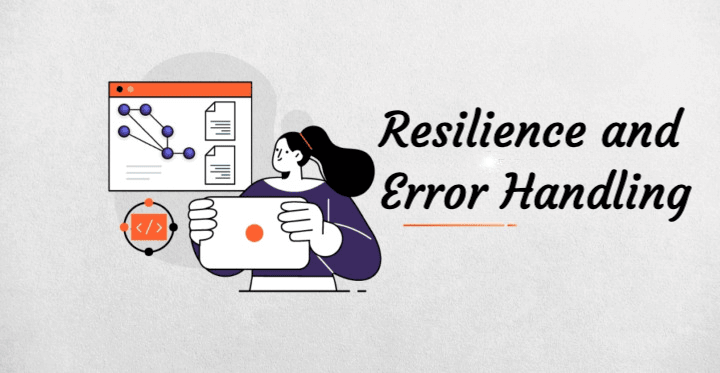Resilience and Error Handling
In this tutorial, we are going to discuss about another key characteristics of distributed systems i.e., Resilience and Error Handling. Resilience and error handling are critical aspects of designing and implementing distributed systems to ensure reliability, fault tolerance, and graceful degradation in the face of failures and unexpected conditions.
Resilience and error handling help minimize the impact of failures and ensure that the system can recover gracefully from unexpected events.
In distributed systems, where components are distributed across multiple nodes and may fail independently, resilience and error handling strategies are essential for maintaining system integrity and providing uninterrupted service to users.

Here’s an overview of resilience and error handling in distributed systems:
1. Fault Tolerance
- Fault tolerance refers to the ability of a distributed system to continue operating correctly and providing service even in the presence of failures or faults in its components.
- Fault tolerance mechanisms include redundancy, replication, failover, and isolation strategies to mitigate the impact of failures and prevent them from causing system-wide outages.
- Redundancy and replication techniques, such as data replication, state replication, and load balancing, distribute workload and data across multiple nodes to ensure that failures in individual components do not disrupt service availability.
2. Graceful Degradation
- Graceful degradation refers to the ability of a system to continue providing limited functionality when certain components or services fail.
- Instead of completely shutting down or becoming unavailable, a gracefully degrading system can continue serving user requests, albeit with reduced functionality or performance.
- Techniques like circuit breakers, timeouts, and fallback mechanisms can be employed to implement graceful degradation in distributed systems.
3. Retry and Backoff Strategies
- Retry mechanisms are used to handle transient failures and recoverable errors by automatically retrying failed operations with backoff and retry policies.
- Implementing retry and backoff strategies can help improve resilience by automatically reattempting failed operations with an increasing delay between retries.
- Retry policies define rules for retrying failed operations, including the maximum number of retries, exponential backoff intervals, jitter, and error code-based retry conditions.
- Retries help mitigate transient network issues, temporary resource constraints, or intermittent failures by giving the system time to recover and stabilize.
4. Error Handling and Logging
- Effective error handling and logging are essential for diagnosing, troubleshooting, and debugging failures in distributed systems.
- Components should log meaningful error messages, exceptions, stack traces, and contextual information to provide insights into the cause and impact of failures.
- Error logs should be aggregated, centralized, and monitored in real-time to enable rapid incident detection, investigation, and resolution.
5. Chaos Engineering
- Chaos engineering is the practice of intentionally injecting failures into a distributed system to test its resilience and identify weaknesses.
- By simulating real-world failure scenarios, you can evaluate the system’s ability to recover and adapt, ensuring that it can withstand various types of failures. Tools like Chaos Monkey or Gremlin can be used to implement chaos engineering in your distributed system.
6. Fallback Mechanisms
- Fallback mechanisms provide alternative paths or fallback strategies to handle failures when primary operations fail or encounter errors.
- Fallback mechanisms may involve switching to secondary services, using cached data, providing default values, or offering alternative user experiences to maintain service continuity in the event of failures.
7. Circuit Breakers
- Circuit breakers are a pattern used to prevent cascading failures in distributed systems by temporarily blocking requests to failing or unhealthy components.
- Circuit breakers monitor the health and responsiveness of downstream services and open the circuit when failures exceed a predefined threshold.
- Once the circuit is open, subsequent requests are rejected or diverted to alternative paths until the downstream service recovers and the circuit is reset.
8. Health Checks and Monitoring
- Health checks and monitoring systems continuously monitor the health, performance, and availability of distributed system components to detect failures and performance issues proactively.
- Health checks verify the readiness and liveness of services, endpoints, and resources, and report their status to monitoring systems for alerting and incident management.
- Monitoring systems aggregate and analyze metrics, logs, traces, and events from distributed components to provide insights into system behavior, identify anomalies, and trigger alerts for potential issues.
By implementing resilience and error handling strategies, and fault tolerance mechanisms, organizations can build distributed systems that are robust, reliable, and capable of providing uninterrupted service even in the face of failures and unexpected conditions. These strategies help mitigate risks, minimize downtime, and maintain service availability, ensuring a positive user experience and business continuity.
That’s all about Resilience and Error Handling in distributed systems. If you have any queries or feedback, please write us email at contact@waytoeasylearn.com. Enjoy learning, Enjoy system design..!!